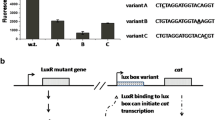Abstract
The enzymes for luminescence in Vibrio fischeri are induced only after the accumulation of a sufficient concentration of a metabolic product (the autoinducer) generated by the bacteria themselves. Genetic analyses by others have previously suggested that biosynthesis of the autoinducer is catalyzed by a single gene product (autoinducer synthetase) presumably from precursors typically present in the bacterial cell. Also, the biosynthesis was predicted to be autocatalytic such that in the presence of autoinducer, more autoinducer synthetase should be produced. We have directly tested these predictions and found that autoinducer synthesis is indeed positively autoregulated. In addition, we have demonstrated autoinducer synthesis in vitro and have tentatively identified the substrates of autoinducer synthetase as S-adenosylmethionine and 3-oxohexanoyl coenzyme A.
Similar content being viewed by others
Abbreviations
- AdoMet:
-
S-adenosylmethionine
- AI:
-
autoinducer, i.e. 3-oxohexsanoyl homoserine lactone
- C-10:
-
decanoyl homoserine lactone
- HPLC:
-
high performance liquid chromatography
- LM:
-
luminescence medium
- LM-BT:
-
luminescence medium without tryptone
- LU:
-
light units
- 3-oxo:
-
3-oxohexanoyl-coenzyme A
- SWC:
-
sea water complete medium
References
Cao J-G, Meighen EA (1989) Purification and structural identification of the autoinducer for the luminescence system of Vibrio harveyi. J Biol Chem 264:21670–21676
Eberhard A (1972) Inhibition and activation of bacterial luciferase synthesis. J Bacteriol 109:1101–1105
Eberhard A, Burlingame AL, Eberhard C, Kenyon GL, Nealson KH, Oppenheimer NJ (1981) Structural identification of autoinducer of Photobacterium fischeri luciferase. Biochemistry 20:2444–2449
Eberhard A, Widrig CA, McBath P, Schineller JB (1986) Analogs of the autoinducer of bioluminescence in Vibrio fischeri. Arch Microbiol 146:35–40
Engebrecht J, Silverman M (1984) Identification of genes and gene products necessary for bacterial bioluminescence. Proc Natl Acad Sci USA 81:4154–4158
Engebrecht J, Nealson K, Silverman M (1983) Bacterial bioluminescence: Isolation and genetic analysis of functions from Vibrio fischeri. Cell 32:773–781
Friedrich WF, Greenberg EP (1983) Glucose repression of luminescence and luciferase in Vibrio fischeri. Arch Microbiol 134:87–91
Greenberg EP, Hasting JW, Ulitzur S (1979) Induction of luciferase synthesis in Beneckea harveyi by other marine bacteria. Arch Microbiol 120:87–91
Hasting JW, Weber G (1963) Total quantum flux of isotropic sources. J Opt Soc Am 53:1410–1415
Kaplan HB, Greenberg EP (1985) Diffusion of autoinducer is involved in regulation of the Vibrio fischeri luminescence system. J Bacteriol 163:1210–1214
Kaplan HB, Greenberg EP (1987) Overproduction and purification of the luxR gene product: the transcriptional activator of the Vibrio fischeri luminescence system. Proc Natl Acad Sci USA 84:6639–6643
Kaplan HB, Eberhard A, Widrig C, Greenberg EP (1985) Synthesis of N-[3-oxo-(4,5-3H2)-hexanoyl]homoserine lactone: biologically active tritium-labelled Vibrio fischeri autoinducer. J Labelled Compds Radiopharm 22:387–395
Kempner ES, Hanson FE (1968) Aspects of light production by Photobacterium fischeri. J Bacteriol 95:975–979
Meighen EA (1988) Enzymes and genes from the lux operons of bioluminescent bacteria. Annu Rev Microbiol 42:151–176
Merkel SM, Eberhard A, Gibson J, Harwood CS (1989) Involvement of coenzyme A thioesters in anaerobic metabolism of 4-hydroxybenzoate by Rhodopseudomonas palustris. J Bacteriol 171:1–7
Mitchell GW, Hasting JW (1971) A stable, inexpensive, solid-state photomultiplier photometer. Anal Biochem 39:243–250
Nealson KH (1977) Autoinduction of bacterial luciferase; occurrence, mechanism and significance. Arch Microbiol 112:73–79
Nealson KH (1978) Isolation, identification, and manipulation of luminous bacteria. In: Colowick SP, Kaplan NO (eds) Methods in enzymology, vol LVII. Academic Press, New York, pp 153–166
Nealson KH, Platt T, Hasting JW (1970) Cellular control of the synthesis and activity of the bacterial luminescent system. J Bacteriol 104:313–322
Shadel GS, Young RY, Baldwin TO (1990) Use of regulated cell lysis in a lethal genetic selection in Escherichia coli: Identification of the autoinducer-binding region of the LuxR protein from Vibrio fischeri ATCC 7744. J Bacteriol 172:3980–3987
Slock J, Van Vriet D, Kolibachuk D, Greenberg EP (1990) Critical regions of the Vibrio fischeri LuxR protein defined by mutational analysis. J Bacteriol 172:3974–3979
Thorpe C (1986) A method for the preparation of 3-ketoacyl-CoA derivatives. Anal Biochem 155:391–394
Ulitzur S, Hasting JW (1979) Autoinduction in a luminous bacterium: a confirmation of the hypothesis. Curr Microbiol 2:345–348
Author information
Authors and Affiliations
Rights and permissions
About this article
Cite this article
Eberhard, A., Longin, T., Widrig, C.A. et al. Synthesis of the lux gene autoinducer in Vibrio fischeri is positively autoregulated. Arch. Microbiol. 155, 294–297 (1991). https://doi.org/10.1007/BF00252215
Received:
Accepted:
Issue Date:
DOI: https://doi.org/10.1007/BF00252215




